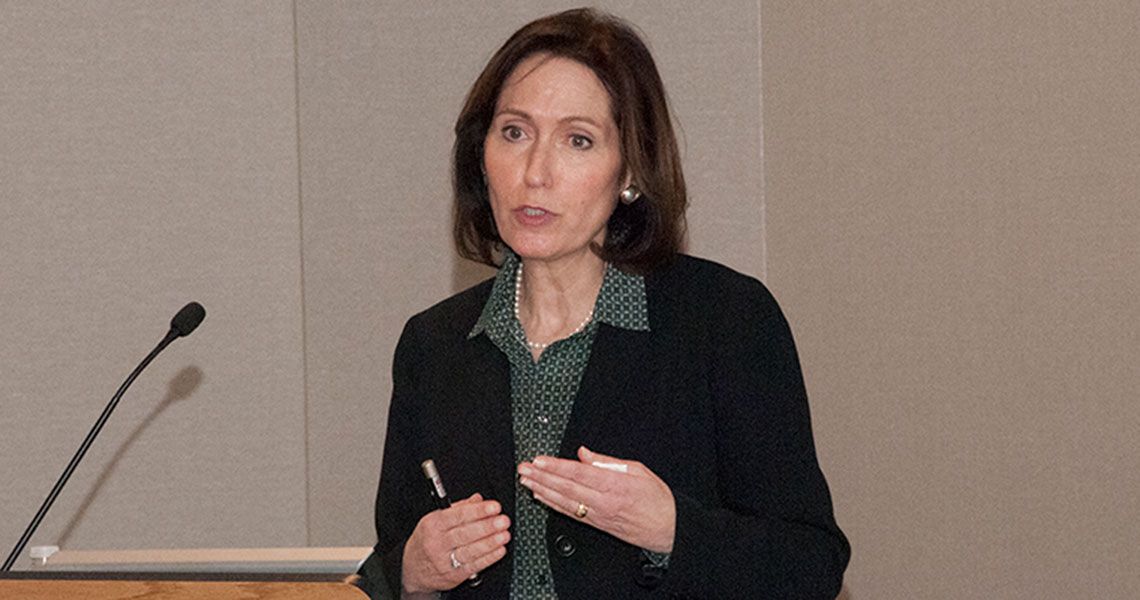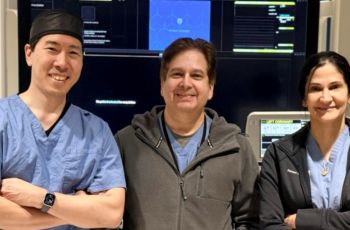Suicide, according to the Centers for Disease Control and Prevention, is second leading cause of death among college students in the United States. It’s a public health crisis, according to Madelyn Gould, Ph.D., M.P.H., which is often made worse by sensationalized media coverage, social media, and the well-meaning, though sometimes misguided, response by student peer groups. Gould, professor of epidemiology in psychiatry, deputy director of research training program in child psychiatry at Columbia University/New York State Psychiatric Institute, took on the challenging topic of suicide among college students during the 21st Annual Seymour Perlin, M.D. Lecture on Suicidology to medical students, psychiatry residents, and faculty of the George Washington University School of Medicine and Health Sciences (SMHS), Dec. 18.
Considered by many to be a pioneer in the field of suicidology, Perlin, Professor Emeritus of Psychiatry and Behavioral Sciences at SMHS directed the school’s psychiatry residency program from 1977 to 1993. In recognition of Perlin’s years of service the Seymour Perlin, M.D. endowment fund was established in 1987 to support an annual grand rounds lecture series focusing on suicide.
“Approximately 1 percent of undergraduates attempted suicide, and six to nine percent seriously considered suicide in the past 12 months,” said Gould during her talk “Youth Suicide Contagion: Implications for Suicide Prevention on College and University Campuses.”
College student suicide rates are not officially tracked on either a national or state level, which is a huge problem according to Gould. “No information is available on numbers or rates of suicide clusters on college or university campuses,” she said, adding that college student suicide rates are estimates based on typical age range for attending college. “Kids who don’t go to college are at an even higher risk of suicide.”
Gould’s talk focused on what she calls suicide contagion, the process by which knowledge of one suicide facilitates the occurrence of a subsequent suicide. She also mentioned emotional contagion, “our ability to empathize with others can make us prone to mimicking or adopting others’ behavior, or to confusing others’ emotions with our own.” Gould referred a Facebook news feed experiment to illustrate the effect. For one week in Jan. 2012, Facebook altered the number of positive and negative posts in the news feeds of 689,003 randomly selected users to see what effect the changes had on the tone of the posts the recipients then wrote. Those who saw more positive posts responded by writing more positive posts themselves. Similarly, seeing more negative content prompted readers to be more negative in their own posts. “Ultimately,” Gould explained, “it showed that emotions can be spread on media.”
Gould also discussed the impact of exposure to media and suicidal peers. When it comes to media and college suicide, research said Gould, finds shows a greater increase in suicide when the frequency of stories increases or the dose-response effect as she calls it. Other factors include dramatic headlines and the prominence of the story, being on the front page. Gould described a content analysis of 497 suicide-related print media reports published in Austria between Jan. 1 and June 30, 2005. The study identified associations between media item content and short-term changes in suicide rates. “In multivariate analysis, repetitive reporting, reports about suicides by jumping, and reporting on public myths about suicide associated with increases in suicide rates,” she said. “Media items describing adoption of coping strategies other than suicidal behavior in adverse circumstances were associated with a decrease in suicide rates.”
“The majority of the studies examining exposure to suicidal behavior of adolescent peers have found a significant association with adolescent suicide attempts,” she said.
Next, Gould defined suicide clusters as an excessive number of suicides occurring in close temporal and/or geographical proximity. “Now, due to social media you can have clusters that are not confined to a geographic location,” she said adding that suicide clusters are primarily a young person’s phenomenon.
Finally, Gould turned her talk toward suicide prevention strategies on college campuses. “In recognition of the need for proactive suicide prevention and postvention policies, the Garret Lee Smith (GLS) program was authorized in 2005 to provide federal funding to campuses for the establishment of suicide prevention and postvention trainings and protocols,” she said.
“Little empirical research has been conducted on the best practices for suicide postventiom,” said Gould. There is hope on the horizon; recently, the Higher Education Mental Health Alliance distributed a new postvention guide for college suicide. Their goals, explained Gould are to facilitate the grieving or adjustment process, stabilize the environment, reduce the risk of negative behaviors, and limit the risk of further suicides through contagion.
In closing, Gould stressed the importance of colleges and universities developing and implementing postvention programs. “Given the prevalence of suicide on college campuses, and the associated risk of contagion and clustering, it is imperative that colleges develop effective and comprehensive postvention strategies.”



